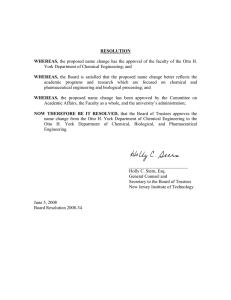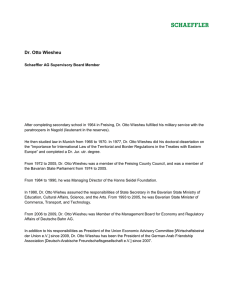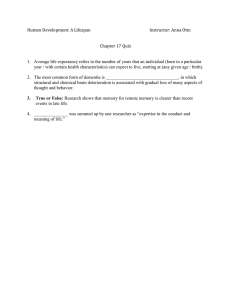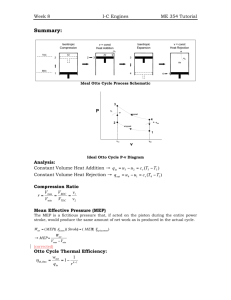II.3 FO : the k-variable fragment of FO FO and k
advertisement
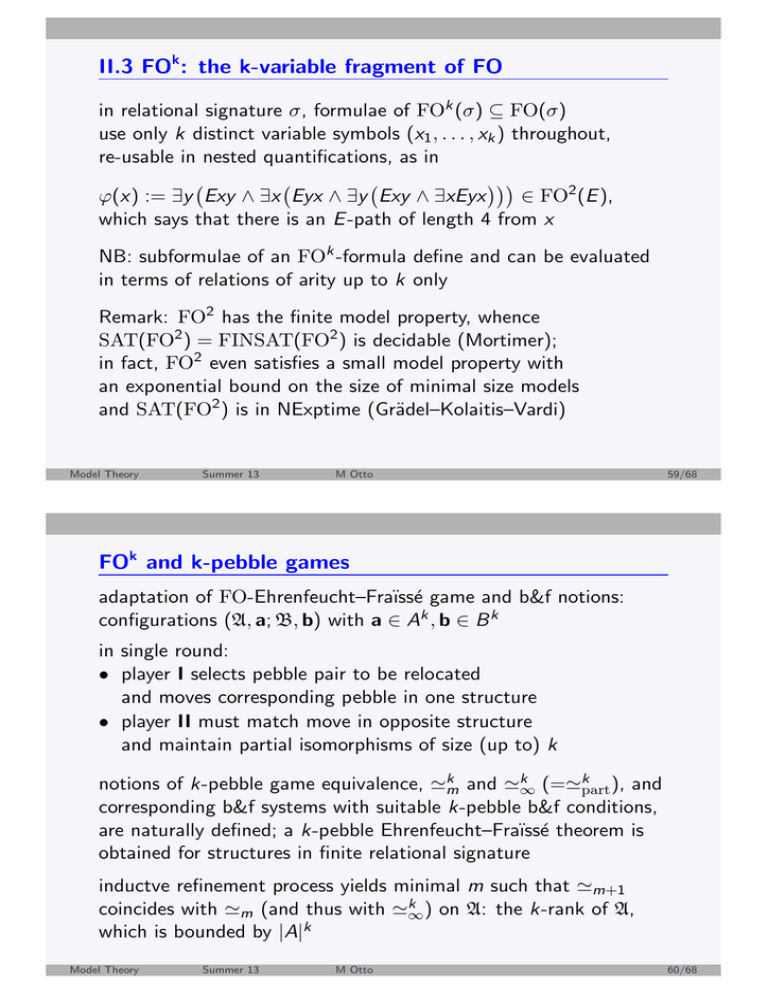
II.3 FOk : the k-variable fragment of FO
in relational signature σ, formulae of FOk (σ) ⊆ FO(σ)
use only k distinct variable symbols (x1 , . . . , xk ) throughout,
re-usable in nested quantifications, as in
ϕ(x) := ∃y Exy ∧ ∃x Eyx ∧ ∃y Exy ∧ ∃xEyx
∈ FO2 (E ),
which says that there is an E -path of length 4 from x
NB: subformulae of an FOk -formula define and can be evaluated
in terms of relations of arity up to k only
Remark: FO2 has the finite model property, whence
SAT(FO2 ) = FINSAT(FO2 ) is decidable (Mortimer);
in fact, FO2 even satisfies a small model property with
an exponential bound on the size of minimal size models
and SAT(FO2 ) is in NExptime (Grädel–Kolaitis–Vardi)
Model Theory
Summer 13
M Otto
59/68
FOk and k-pebble games
adaptation of FO-Ehrenfeucht–Fraı̈ssé game and b&f notions:
configurations (A, a; B, b) with a ∈ Ak , b ∈ B k
in single round:
• player I selects pebble pair to be relocated
and moves corresponding pebble in one structure
• player II must match move in opposite structure
and maintain partial isomorphisms of size (up to) k
notions of k-pebble game equivalence, ≃km and ≃k∞ (=≃kpart ), and
corresponding b&f systems with suitable k-pebble b&f conditions,
are naturally defined; a k-pebble Ehrenfeucht–Fraı̈ssé theorem is
obtained for structures in finite relational signature
inductve refinement process yields minimal m such that ≃m+1
coincides with ≃m (and thus with ≃k∞ ) on A: the k-rank of A,
which is bounded by |A|k
Model Theory
Summer 13
M Otto
60/68
complete k-pebble invariants
inductive pre-order refinement of levels ≃km over individual A
yields a linearly ordered invariant Ik (A, a)
as a structural abstraction of (A, a)/ ≃k∞
based on inductive refinement process
of levels Ak /(≃km )A −→ Ak /(≃k∞ )A ,
sorting in new classes lexicographically,
terminating within k-rank of A many steps
for fixed finite relational σ, Ik provides concise, Ptime computable
complete invariant w.r.t. ≃k∞ over Fin(σ):
for all A, B ∈ Fin(σ), a ∈ Ak , b ∈ B k :
A, a ≃k∞ B, b ⇔ Ik (A, a) ≃ Ik (B, b)
(∗)
due to its linearly ordered nature, it is ‘essentially syntactic’,
i.e., we could replace ≃ by = in (∗) after normalisation
Model Theory
Summer 13
M Otto
61/68
II.4 Fixpoint logics in descriptive complexity
(A) descriptive comlexity:
logical (or other machine-independent)
characterisations of complexity classes
towards an alternative analysis and understanding
of the levels of algorithmic complexity of problems
example: Büchi’s theorem, giving a precise match
computational power
of finite automata
!
expressive power
of MSO
FMT is concerned with the complexity of structural problems,
especially decision problems based on properties of structures;
the study of these (boolean) queries is richer than the standard
setting, since coding & representation impose semantic constraints
Model Theory
Summer 13
M Otto
62/68
review: computational complexity
NB: complexity classes are classes of problems, not of algorithms;
defined in terms of resource bounds on Turing machines
(think: “worst-case complexity of best possible machine”)
(B) standard complexity classes:
P/Ptime: polynomial time, termination within p(n) steps
on inputs of size n, for some polynomial p
NP:
non-deterministic polynomial time, based on
polynomial depth non-deterministic procedure
potentially exponentially branching search & verification,
or: guessing of polynomial size certificate and Ptime check
Pspace:
polynomial space, termination with polynomially
bounded overall memory (tape) consumption
potentially exponential time
Model Theory
Summer 13
M Otto
63/68
the need for coding and the role of order
(C) structures as inputs; queries
standard input for Turing machines (or for standard algorithms)
are strings/words over some suitable finite alphabet
input structures A ∈ Fin(σ) have to be encoded as words;
as part of the correctness condition on admissible algorithms,
different encodings of the same (or isomorphic) structures
as input have to lead to the same output result:
• queries on Fin(σ) are, by definition, ≃-invariant;
this is a non-trivial semantic constraint, which
is computationally non-trivial below NP
• linearly ordered structures admit canonical encoding schemes
that are unambiguous, thus trivialising the issue
the crucial role of order-invariance in FMT
Model Theory
Summer 13
M Otto
64/68
Fagin’s theorem
observation: FO-definable queries are in Ptime (even Logspace)
theorem (Fagin)
NP ≡ ∃-SO, existential second-order logic captures NP,
i.e., the following are equivalent for all C ⊆ Fin(σ):
(i) C is definable by a sentence of existential second-order logic:
C = FMod(∃Xϕ(X)) for some ϕ(X) ∈ FO(σ ∪ {X})
(ii) the decision problem for C ⊆ Fin(σ) is in NP
NB: this is an assertion on the model checking complexity of ∃-SO,
together with a matching expressive completeness result for ∃-SO !
NB: order is dispensable, since available in existential quantification
Model Theory
Summer 13
M Otto
65/68
coding of configurations and runs
encode nk -bounded runs of (non-deterministic) TM
M = (Γ, Q, q0 , q + , q − , ∆) on input structures
(A, <) = ({0, . . . , |A| − 1}, <, . . .) with linear ordering <
over (n, <) = ({0, . . . , n − 1}, <) for n = |A|
• use Ak as numerical domain for numbers encoded to base n
• encode run (Ct )t<nk with Ct = (qt , ℓt , ρt )
as the graph of a function Ak × Ak → A × Ak × A
i.e., as a relation R ⊆ A3k+2
initial configuration C0
consistency of Ct
Ct+1 with ∆
in FO(σ ∪ {R, <})
accepting final state
Fagin: (implicit) FO-definability
explicit ∃-SO definability
also without (the invariant use of) order
other capturing results with order → below
Model Theory
Summer 13
M Otto
66/68
relational recursion: fixpoint logics
ϕ(X , x) ∈ FOk (σ ∪ {X }) with k-ary X and matching x
induces operation on P(Ak ), uniformly across all A ∈ Fin(σ):
FϕA : P(Ak ) −→ P(Ak )
P 7−→ {a ∈ Ak : A, P, a |= ϕ}
easy to see: if ϕ(X , x) is X -positive, this operation is monotone
(preservation result/classically only: matching expressive completeness)
natural extensions of FO, esp. for FMT, provide recursion
mechanisms based on such definable operations
• least fixpoint logic LFP has least and greatest fixpoints
for positive/monotone operations
• partial fixpoint logic PFP has fixpoints
for arbitrary operations (with default ∅)
Model Theory
Summer 13
M Otto
67/68
capturing results with order
thm (Immerman–Vardi)
Ptime ≡ LFP
over linearly ordered structures
i.e., t.f.a.e. for every class C ⊆ Fin(σ)
of linearly ordered σ-structures:
(i) C ⊆ Fin(σ) is decidable in NP
(ii) C is definable within Fin(σ) by a sentence of LFP(σ)
thm (Abiteboul–Vianu)
Pspace ≡ PFP
over linearly ordered structures
remarks: order is crucial, simple fixpoints over FO suffice
model-checking in Ptime/Pspace is obvious
expressive completeness: coding & fixpoint recursion
Model Theory
Summer 13
M Otto
68/68
